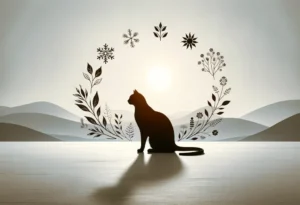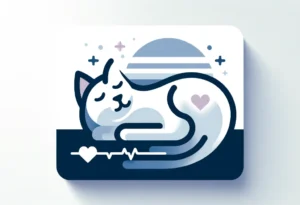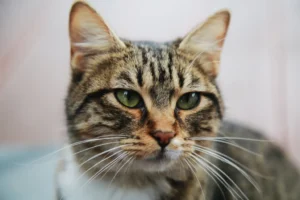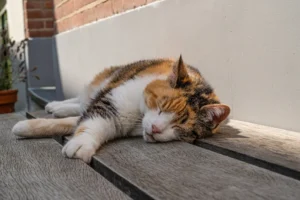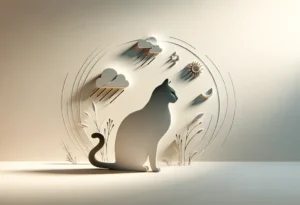As the leaves turn and the daylight wanes, it’s not just humans who might feel a dip in their mood. Who knew that Mr. Whiskers could face his own set of winter blues? Cats, just like their human companions, can experience seasonal changes in mood that could be akin to Seasonal Affective Disorder (SAD), and it’s more common than you might think.
In this post, we’ll walk you through how to help your feline friend navigate through these seasonal changes, ensuring they remain purr-fectly content, no matter the weather outside.
Key takeaways:
- Observe your cat for changes in appetite, sleep, and mood to catch early signs of SAD.
- Enhance their environment with sunspots, interactive toys, and consistent routines to combat the winter blues.
- Consider light therapy and consult a vet if symptoms persist or worsen, ensuring your cat’s health and happiness.
What is Seasonal Affective Disorder in Cats?
Seasonal Affective Disorder (SAD) in cats is more than just a case of the “winter blues”. It’s a type of depression that occurs at a certain time of year, usually in the colder, darker months.
Just like humans, cats can react to the lack of sunlight, exhibiting changes in behavior that signal something isn’t quite right. SAD in cats can manifest through various signs, including but not limited to changes in appetite, sleep patterns, and overall activity levels.
How Can You Tell If Your Cat Has SAD?
Spotting SAD in your furry friend involves keen observation. Here are a few tell-tale signs:
- Changes in Appetite: Your cat might start eating less or show no interest in its food.
- Altered Sleep Patterns: If your cat is sleeping more than usual, or at odd hours, it could be a sign.
- Decreased Activity: A noticeable reduction in playfulness or reluctance to engage in activities they once enjoyed.
- Mood Changes: Look out for signs of withdrawal, increased irritability, or less interest in interaction.
Taking note of these behaviors over a few days can give you a clearer picture of what might be affecting your cat. Remember, every cat is unique, so changes might be subtle or take time to become apparent.
What Causes Seasonal Affective Disorder in Cats?
The main culprit behind SAD in felines is the reduced exposure to sunlight during shorter winter days. Sunlight plays a crucial role in regulating our body clocks, or circadian rhythms, and this is true for cats as well. Less daylight can disrupt their internal clock, affecting hormone production, which in turn influences their mood and behavior.
Another factor to consider is the change in your own behavior during the colder months. Cats are highly sensitive to their environment and their owner’s emotions. If you’re feeling the winter blues, there’s a good chance your cat might pick up on this and mirror your mood.
While we can’t control the weather, there are effective ways to help your cat through these gloomier months:
- Sunspot Setup: Make the most of the sunlight available by setting up a cozy spot near a window where your cat can bask in the sunshine.
- Interactive Play: Engage your cat in playtime, even if it means getting creative indoors. Laser pointers, feather wands, or even a simple box can work wonders in lifting their spirits.
- Routine Rhythms: Keeping a consistent routine helps provide a sense of safety and security, which can be comforting during the unsettling dark days of winter.
A rather unique tip to consider involves music therapy. Recent studies have shown that playing soft, calming music can have a positive effect on cats, reducing stress and anxiety. Finding a playlist designed specifically for cats, and playing it during the day, can offer an additional layer of comfort and may just help ease those SAD symptoms.
Addressing SAD in pets is about being observant, patient, and proactive in offering support. By acknowledging the impact of seasonal changes on your cat’s well-being and taking steps to alleviate their discomfort, you foster a happier, healthier environment for both of you. Let’s not forget, in tackling these winter woes together, you’re also strengthening the bond with your furry companion.
How Can You Help Your Cat Overcome Seasonal Affective Disorder?
Winter blues aren’t just a human thing; our furry friends can feel the pinch of shorter days and less sunlight, too. When it comes to helping our cats shake off those SAD feelings, there’s plenty you can do to turn their frowns upside down. Let’s dive into some paws-itively effective strategies.
Create a Stimulating Environment
It’s all about keeping those kitty brains busy and engaged. Transforming your home into a cat’s playground is easier than you think and doesn’t have to break the bank. Here are a few ideas:
- DIY Fun: Get crafty with homemade toys or a cardboard box haven. Sometimes, the box is more exciting than the toy that came in it!
- Climbing and Perches: Cats love to oversee their kingdom from the highest vantage points. Wall shelves or a new cat tree can do wonders.
- Interactive Toys: Puzzle feeders and laser toys encourage mental and physical activity. It’s like hitting two birds with one stone – they’re having fun and working out their brain!
Diet and Exercise
A well-balanced diet and regular exercise are foundational to a happy and healthy life for your cat, especially during those mood-dipping months. Here’s the scoop:
- Quality Diet: Opt for nutrient-rich food that supports overall wellbeing. Sometimes, a slight tweak in their diet can bring about a noticeable change in their mood.
- Play Time: Engage your cat in play. String toys, balls, or even a crumbled piece of paper can get them moving. Aim for at least two 15-minute play sessions each day.
Light Therapy
Here’s where things get illuminating – literally. Light therapy, also known as phototherapy, can be a secret weapon against SAD in cats. Mimicking sunlight, certain light boxes or bulbs can help regulate your cat’s mood and sleep cycles. Here’s a unique tip not often shared: positioning a bird feeder outside a securely closed window can provide natural entertainment and encourage your cat to bask in the sunlight, combining light therapy with visual stimulation. How’s that for killing two birds with one stone (figuratively speaking)?
When Should You See a Vet?
Despite our best efforts, some situations are best handled by professionals. It’s crucial to know when to throw in the towel and consult with a veterinarian.
Recognizing the Signs
Keep an eye out for signs that your cat’s SAD might be more than you can handle alone. This includes drastic changes in behavior, appetite, or activity levels that don’t seem to improve with your interventions.
Professional Intervention
A vet can offer insight into whether your cat’s symptoms are indeed SAD-related or if there’s an underlying health issue at play. They might suggest:
- Health Check: A thorough health screening to rule out physical health issues.
- Diet Adjustment: Professional advice on optimizing your cat’s diet.
- Behavioral Therapy: Sometimes, a referral to a veterinary behaviorist is in order.
Remember, it’s better to be safe than sorry. If you’re ever in doubt about your cat’s health or happiness, a vet visit is the right call.
Creating a joy-filled environment for your cat during the darker months isn’t just possible; it’s a fantastic way to deepen your bond. Whether it’s through upbeat play sessions, strategic dietary tweaks, or even innovative light therapy, remember that the effort you put in can make a world of difference to your furry friend’s well-being. And when in doubt, always reach out to your vet. After all, a happy cat means a happy home.
Alex, a passionate animal lover, has experience in training and understanding animal behavior. As a proud pet parent to two dogs and three cats, he founded AnimalReport.net to share insights from animal experts and expand his knowledge of the animal kingdom.


